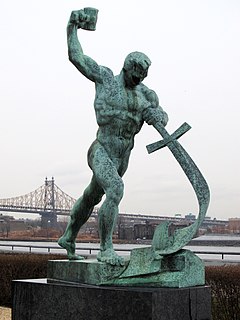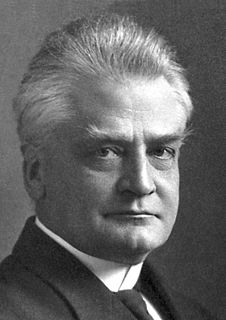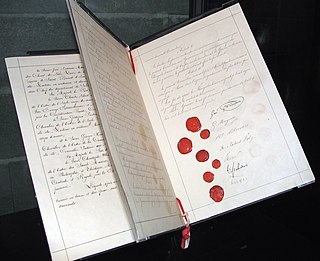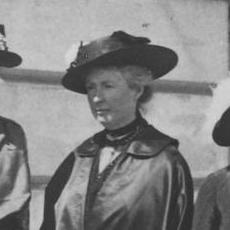See also
| This disambiguation page lists articles associated with the title Peace Conference. If an internal link led you here, you may wish to change the link to point directly to the intended article. |
A peace conference is a diplomatic meeting where representatives of certain states, armies, or other warring parties converge to end hostilities and sign a peace treaty.
Peace conference may also refer to:
| This disambiguation page lists articles associated with the title Peace Conference. If an internal link led you here, you may wish to change the link to point directly to the intended article. |

The Permanent Court of Arbitration (PCA) is an intergovernmental organization located at The Hague in the Netherlands. The PCA is not a court in the traditional sense but provides services of arbitral tribunal to resolve disputes that arise out of international agreements between member states, international organizations or private parties. The cases span a range of legal issues involving territorial and maritime boundaries, sovereignty, human rights, international investment, and international and regional trade. The PCA is constituted through two separate multilateral conventions with a combined membership of 122 states. The organization is not a United Nations agency, but the PCA is an official United Nations Observer.

Disarmament is the act of reducing, limiting, or abolishing weapons. Disarmament generally refers to a country's military or specific type of weaponry. Disarmament is often taken to mean total elimination of weapons of mass destruction, such as nuclear arms. General and Complete Disarmament was defined by the United Nations General Assembly as the elimination of all WMD, coupled with the “balanced reduction of armed forces and conventional armaments, based on the principle of undiminished security of the parties with a view to promoting or enhancing stability at a lower military level, taking into account the need of all States to protect their security.”

An armistice is a formal agreement of warring parties to stop fighting. It is not necessarily the end of a war, as it may constitute only a cessation of hostilities while an attempt is made to negotiate a lasting peace. It is derived from the Latin arma, meaning "arms" and -stitium, meaning "a stopping".

A full metal jacket (FMJ) bullet is a small-arms projectile consisting of a soft core encased in a shell of harder metal, such as gilding metal, cupronickel, or, less commonly, a steel alloy. A bullet jacket generally allows for higher muzzle velocities than bare lead without depositing significant amounts of metal in the bore. It also prevents damage to bores from steel or armor-piercing core materials. In military nomenclature, it is often labeled ball ammunition.
Non-combatant is a term of art in the law of war and international humanitarian law to refer to civilians who are not taking a direct part in hostilities; persons, such as combat medics and military chaplains, who are members of the belligerent armed forces but are protected because of their specific duties ; combatants who are placed hors de combat; and neutral persons not involved in fighting for one of the belligerents involved in a war. This particular status was first recognized under the Geneva Conventions with the First Geneva Convention of 1864.

Christian Lous Lange was a Norwegian historian, teacher, and political scientist. He was one of the world's foremost exponents of the theory and practice of internationalism.

Auguste Marie François Beernaert was the 14th Prime Minister of Belgium from October 1884 to March 1894.

Tobias Michael Carel Asser was a Dutch lawyer and legal scholar of Jewish background.
Hague Convention may refer to:

The Hague Conventions of 1899 and 1907 are a series of international treaties and declarations negotiated at two international peace conferences at The Hague in the Netherlands. Along with the Geneva Conventions, the Hague Conventions were among the first formal statements of the laws of war and war crimes in the body of secular international law. A third conference was planned for 1914 and later rescheduled for 1915, but it did not take place due to the start of World War I.

The Peace Palace is an international law administrative building in The Hague, the Netherlands. It houses the International Court of Justice, the Permanent Court of Arbitration (PCA), The Hague Academy of International Law and the Peace Palace Library.

Viscount Motono Ichirō was a statesman and diplomat, active in Meiji period Japan.

Count Mikhail Nikolayevich Muravyov or Muraviev was a Russian statesman who advocated transferring the attention of Russian foreign policy from Europe to the Far East. He is probably best remembered for having initiated the Hague Peace Conference.

The Women's International League for Peace and Freedom (WILPF) is a non-profit non-governmental organization working "to bring together women of different political views and philosophical and religious backgrounds determined to study and make known the causes of war and work for a permanent peace" and to unite women worldwide who oppose oppression and exploitation. WILPF has national sections in 37 countries.

James Brown Scott, J.U.D. was an American authority on international law.
A peace conference is a diplomatic meeting where representatives of certain states, armies, or other warring parties converge to end hostilities and sign a peace treaty.
A peace congress, in international relations, has at times been defined in a way that would distinguish it from a peace conference, as an ambitious forum to carry out dispute resolution in international affairs, and prevent wars. This idea was widely promoted during the nineteenth century, anticipating the international bodies that would be set up in the twentieth century with comparable aims.

The Geneva Conventions comprise four treaties, and three additional protocols, that establish the standards of international law for humanitarian treatment in war. The singular term Geneva Convention usually denotes the agreements of 1949, negotiated in the aftermath of the Second World War (1939–1945), which updated the terms of the two 1929 treaties, and added two new conventions. The Geneva Conventions extensively defined the basic rights of wartime prisoners, established protections for the wounded and sick, and established protections for the civilians in and around a war-zone. The treaties of 1949 were ratified, in whole or with reservations, by 196 countries. Moreover, the Geneva Convention also defines the rights and protections afforded to non-combatants; however, because the Geneva Conventions are about people in war, the articles do not address warfare proper—the use of weapons of war—which is the subject of the Hague Conventions, and the bio-chemical warfare Geneva Protocol.
The International Congress of Women was created so that groups of existing women’s suffrage movements could come together with other women’s groups arounds the world. It served as a way for women organizations across the nation to establish formal means of communication and to provide more opportunities for women to ask the big questions relating to feminism at the time. The congress has been utilized by a number of feminist and pacifist events since 1878. A few groups that participated in the early conferences were The International Council of Women (ICW), The International Alliance of Women (IAW) and The Women’s International League for Peace and Freedom (WILPF).

Cornelia Ramondt-Hirschmann was a Dutch teacher, feminist, pacifist and theosophist active in the first half of the twentieth century. She was one of the women who participated in the push by pacifist feminists during World War I for world leaders to develop a mediating body to work for peace. The culmination of their efforts would be the achievement of the League of Nations when the war ended. Between 1935 and 1937, she served as one of the three international co-chairs of the Women's International League for Peace and Freedom (WILPF).